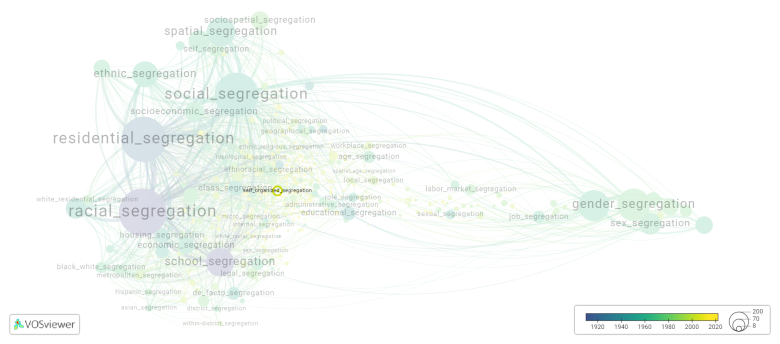Self organized segregation: Difference between revisions
(Creating page) |
(Creating page) |
||
| Line 20: | Line 20: | ||
[[File:self_organized_segregation.png|780x780px]] | [[File:self_organized_segregation.png|780x780px]] | ||
Visualization based on the [[How_to_cite_Segregation_Wiki| research]] | |||
For the complete network of associated segregation forms, see: | For the complete network of associated segregation forms, see: | ||
year of publication https://tinyurl.com/2235lkhw | * First year of publication https://tinyurl.com/2235lkhw | ||
Louvain clusters https://tinyurl.com/2d8wg5n3 | * Louvain clusters https://tinyurl.com/2d8wg5n3 | ||
* Betweenness centrality https://tinyurl.com/223udk5r | |||
* Disciplines where segregation forms first appeared https://tinyurl.com/244d8unz | |||
==References== | ==References== | ||
==Notes== | ==Notes== | ||
Revision as of 13:41, 3 October 2024
Date and country of first publication[1]
2014
Netherlands
Definition
Self-organized segregation refers to the phenomenon of individuals or groups voluntarily segregating themselves from others based on certain characteristics such as race, ethnicity, or socio-economic status. Unlike enforced segregation, which is imposed by external forces such as governments or institutions, self-organized segregation is driven by personal choices and preferences.
Self-organized segregation can occur in various settings, including neighborhoods, schools, workplaces, or even online communities. It typically arises when people with similar backgrounds, interests, or beliefs gather together, creating homogeneous social groups. This voluntary separation can reinforce existing social divisions and lead to limited interactions and understanding between different groups.
One example of self-organized segregation is residential segregation, where individuals or families choose to live in neighborhoods predominantly populated by people of their own race or socio-economic status. This can lead to disparities in access to resources and opportunities and perpetuate inequalities.
Self-organized segregation can also occur in educational institutions, where students and parents may choose schools based on factors such as academic reputation, demographics, or cultural affinity. This can lead to the concentration of certain groups in specific schools and contribute to unequal educational outcomes.
While self-organized segregation may be driven by personal preferences or perceived benefits, it can have negative consequences for social cohesion and equality. It can limit exposure to diverse perspectives, hinder social integration, and perpetuate stereotypes and prejudice. Overcoming self-organized segregation requires intentional efforts to promote inclusivity, diversity, and equal opportunities for all.
See also
Related segregation forms
Self organized segregation is frequently discussed in the literature with the following segregation forms:
ethnic segregation, school segregation, residential segregation, unintended residential segregation

Visualization based on the research
For the complete network of associated segregation forms, see:
- First year of publication https://tinyurl.com/2235lkhw
- Louvain clusters https://tinyurl.com/2d8wg5n3
- Betweenness centrality https://tinyurl.com/223udk5r
- Disciplines where segregation forms first appeared https://tinyurl.com/244d8unz
References
Notes
- ↑ Date and country of first publication as informed by the Scopus database (December 2023).
At its current state, this definition has been generated by a Large Language Model (LLM) so far without review by an independent researcher or a member of the curating team of segregation experts that keep the Segregation Wiki online. While we strive for accuracy, we cannot guarantee its reliability, completeness and timeliness. Please use this content with caution and verify information as needed. Also, feel free to improve on the definition as you see fit, including the use of references and other informational resources. We value your input in enhancing the quality and accuracy of the definitions of segregation forms collectively offered in the Segregation Wiki ©.
Self organized segregation appears in the following literature
Stoica V.I., Flache A. (2014). From schelling to schools: A comparison of a model of residential segregation with a model of school segregation. JASSS, 17(1), -. University of Surrey.https://doi.org/10.18564/jasss.2342
